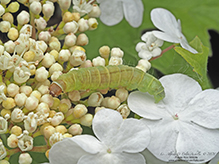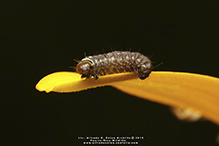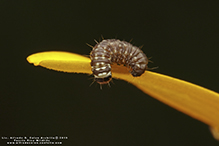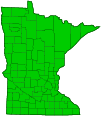Butterflies and moths
(order Lepidoptera)
Overview • Description • Distribution • Taxonomy

Overview
Lepidoptera is the order of insects commonly called butterflies and moths. As of 2007, there were about 174,250 described Lepidopteran species in 126 families in 46 superfamilies worldwide. A more recent estimate suggests that there are probably about 300,000 described and undescribed species. Most species by far occur in the tropics. There are more than 12,766 species in 89 families in North America north of Mexico. At least 220 of those are introduced, non-native species. There are at least 1,206 species in 27 superfamilies in Minnesota.
Lepidoptera is a very widespread and widely recognized order. Lepidopterans occur on every continent except Antarctica.
Lepidopterans feed only on plants. Most larvae feed on plant foliage. Many species are important agricultural pests. Most adults feed on flower nectar. In the process, they brush against flower stamens and pick up pollen, which they transfer to the stigma of the next flower they visit. Some adults do not feed.
Description
The mouthparts are optimized for sucking. They take the form of an elongated, coiled, tube (proboscis) with one to five segments. There is also a pair of conspicuous, well developed, finger-like, sense organs (labial palps). The labial palps are densely covered with hair-like scales and appear furry. The maxillary palps on almost all species, and the jaws (mandibles) on most species, are absent, or if present, are not functional (vestigial). The antennae are long and slender. On moths, they are sometimes feather-like (plumose). On butterflies, they are always knobbed at the tip.
Parts of the thorax and abdomen are covered with hair-like scales.
Almost all species have four membranous wings. The forewings are a little larger than the hindwings. The wings are entirely or mostly covered with minute, flattened, blade-like scales.
The larvae (caterpillars) are cylindrical. The thorax has three segments, the abdomen has ten segments. There are three pairs of short true legs on the thorax, and up to five pairs of leg-like structures (prolegs) on the abdomen. The head is well developed and has mandibles for chewing.
Distribution |
||
|
Sources Biodiversity occurrence data published by: Minnesota Biodiversity Atlas (accessed through the Minnesota Biodiversity Atlas Portal, bellatlas.umn.edu, 4/19/2025).
|
|
| 4/19/2025 | ||
Taxonomy
Class
Insecta (insects)
Subclass
Pterygota (winged and once-winged insects)
Subordinate Taxa
Superfamily Acanthopteroctetoidea ![]()
Superfamily Adeloidea (fairy moths and allies) ![]()
![]()
Superfamily Agathiphagoidea
Superfamily Alucitoidea (many-plumed and false plume moths) ![]()
![]()
Superfamily Andesianoidea
Superfamily Bombycoidea (Hawk, Sphinx, Silk, Emperor, and Allied Moths) ![]()
![]()
Superfamily Calliduloidea
Superfamily Carposinoidea (=Copromorphoidea) (fruitworm moths) ![]()
![]()
Superfamily Choreutoidea (metalmark moths) ![]()
![]()
Superfamily Cossoidea (carpenter, leopard, goat, and allied moths) ![]()
![]()
Superfamily Douglasioidea ![]()
Superfamily Drepanoidea (hooktip moths and allies) ![]()
![]()
Superfamily Epermenioidea (fringe-tufted moths) ![]()
![]()
Superfamily Eriocranioidea (eriocraniid moths) ![]()
![]()
Superfamily Galacticoidea (galacticid moths) ![]()
Superfamily Gelechioidea (curved-hord moths) ![]()
![]()
Superfamily Geometroidea (Geometrid and Swallowtail Moths) ![]()
![]()
Superfamily Gracillarioidea (ribbed cocoon-maker and leaf blotch miner moths) ![]()
![]()
Superfamily Hepialoidea (ghost moths and swift moths) ![]()
![]()
Superfamily Heterobathmioidea
Superfamily Hyblaeoidea (teak moths) ![]()
Superfamily Immoidea
Superfamily Lasiocampoidea (tent caterpillar and lappet moths) ![]()
![]()
Superfamily Lophocoronoidea
Superfamily Micropterigoidea (mandibulate archaic moths) ![]()
Superfamily Mimallonoidea (sack-bearer moths) ![]()
Superfamily Neopseustoidea (archaic sun moths) ![]()
Superfamily Nepticuloidea (pygmy leafminer moths) ![]()
![]()
Superfamily Noctuoidea (Owlet Moths and Allies) ![]()
![]()
Superfamily Palaephatoidea
Superfamily Papilionoidea (Butterflies) ![]()
![]()
Superfamily Pterophoroidea (Plume Moths and Allies) ![]()
![]()
Superfamily Pyraloidea (Pyralid and Crambid Snout Moths) ![]()
![]()
Superfamily Schreckensteinioidea (bristle-legged moths) ![]()
![]()
Superfamily Sesioidea (clearwing moths)
Superfamily Simaethistoidea
Superfamily Thyridoidea (picture-winged leaf moths) ![]()
![]()
Superfamily Tineoidea (Bagworms, Clothes Moths, and Allies) ![]()
![]()
Superfamily Tischerioidea (trumpet leafminer moths) ![]()
![]()
Superfamily Tortricoidea (tortricid leafroller moths and allies) ![]()
![]()
Superfamily Urodoidea (false burnet moths) ![]()
![]()
Superfamily Whalleyanoidea
Superfamily Yponomeutoidea (ermine moths and allies) ![]()
![]()
Superfamily Zygaenoidea (flannel, slug caterpillar, leaf skeletonizer and allied moths) ![]()
![]()
Synonyms
Common Names
butterflies and moths
Glossary
Palp
Short for pedipalp. A segmented, finger-like process of an arthropod; one is attached to each maxilla and two are attached to the labium. They function as sense organs in spiders and insects, and as weapons in scorpions. Plural: palpi or palps.
Proboscis
The tube-like protruding mouthpart(s) of a sucking insect.
Proleg
A fleshy structure on the abdomen of some insect larvae that functions as a leg, but lacks the five segments of a true insect leg.
Visitor Photos
Share your photo of this insect.
This button not working for you?
Simply email us at info@MinnesotaSeasons.com.
Attach one or more photos and, if you like, a caption.
Alfredo Colon |
||
 |
 |
|
 |
 |
|
MinnesotaSeasons.com Photos
|

Slideshows

Visitor Videos
Share your video of this insect.
This button not working for you?
Simply email us at info@MinnesotaSeasons.com.
Attach a video, a YouTube link, or a cloud storage link.
Other Videos
Lepidoptera: The Butterflies and Moths - Order Spotlight
Insect Spotlight Project

Visitor Sightings
Report a sighting of this insect.
This button not working for you?
Simply email us at info@MinnesotaSeasons.com.
Be sure to include a location.
Minnesota Seasons Sightings




